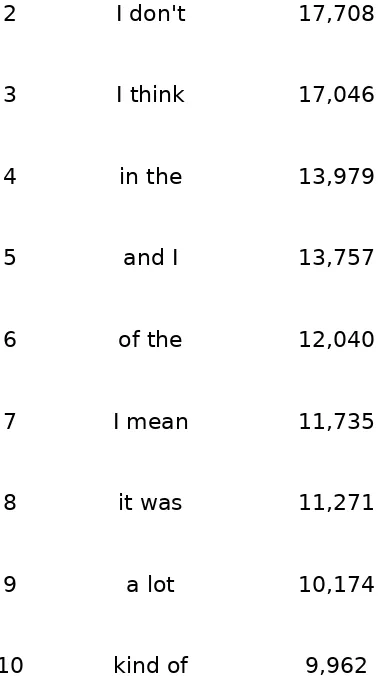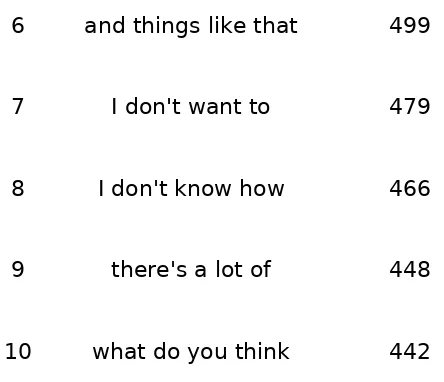SATUAN ACARA PERKULIAHAN JURUSAN SASTRA INGGRIS
FAKULTAS SASTRA UNIVERSITAS GUNADARMA
Mata Kuliah : KOSA KATA 2
Semester : GENAP
Bobot : 2 SKS
Jumlah Pertemuan : 14 X 120 menit
Deskripsi
Mata kuliah ini berkenaan dengan pengembangan kemampuan memahami dan mengungkapkan makna dengan menggunakan diksi Bahasa Inggris yang tepat sesuai konteks.
Standar Kompetensi
Mahasiswa mampu menggunakan pengetahuan dan pemahamannya tentang diksi Bahasa Inggris untuk mengungkapkan makna secara tulis maupun lisan dengan tepat sesuai konteks.
Perte-muan
Materi Pokok Bahasan Kegiatan Belajar Mengajar
Pentingnya High-frequency Words dan Academic Words
Pengetahuan tentang Word Knowledge
Penjelasan dan diskusi tentang High-frequency Words dan Academic Words
1-6, 22-67;
Words yang
belum dikuasai mahasiswa
Vocabulary learning strategies
Memberi umpan balik/feed back untuk hasil tes texts, Literary texts, dsb.
Form
(pronunciation, spelling, afxese
Meaning (one context, different contexts,
associationse
Use (word class, collocations,
Mengidentifkasi Form
(pronunciation, spelling, afxese dalam Mass media texts, Academic texts, Literary texts, dsb.
Mengidentifkasi Meaning (one context, different contexts, associationse dalam Mass media texts, Academic texts,
koran, majalah, jurnal, novel, puisi, siaran radio dan
degrees of
formality, style Literary texts, dsb. Mengidentifkasi
Use (word class, collocations, degrees of formality, stylee dalam Mass media texts, Academic texts, Literary texts, dsb.
Menggunakan kata terutama High-frequency Words dan Academic Words dalam teks tulis (writing) dan lisan (speaking) 9-10 Soal (bentuk
tulis dan lisan) untuk mengukur
LATIHAN SOAL Nation (2008)
11-12 Contoh-contoh chunks,
collocations, idioms dalam teks tulis dan lisan dari berbagai sumber
Chunks, collocations,
idioms Mengidentifkasi chunks, collocations, idioms dalam berbagai teks dan
89-104; Lewis
(2002b) 17-43; Lewis (2000) hal 28-46;
koran, majalah, jurnal,
novel, puisi, siaran radio dan
televise, internet. 13-14 Soal tertulis
(writing) dan lisan (speaking, monolog)
dengan topik sesuai program studi.
LATIHAN SOAL
Pengayaan: Mahasiswa ditugasi membaca buku/novel berbahasa Inggris sesuai minat masing-masing dan membuat ringkasannya, dikumpulkan pada akhir semester.
Rujukan:
Coxhead, A. 1998. An Academic Word List. Wellington: Victoria University of Wellington.
Folse, K. 2004. Vocabulary Myths: Applying Second Language Research to Classroom Teaching. Ann Arbor: University of Michigan Press.
---. 2000. There is Nothing as Practical as a Good Theory. In M. Lewis. Ed. Teaching Collocation: Further Developments in the Lexical Approach. London: Language Teaching Publications.
---. 2002b. Implementing the Lexical Approach: Putting Theory into Practice. Boston: Heinle.
Nation, Paul. 2001. Learning Vocabulary in Another Language: Acquisition and Pedagogy. Cambridge: Cambridge University Press.
---. 2008. Teaching Vocabulary: Strategies and Techniques. Boston : Heinle. Schmitt, N. 2000. Vocabulary in Language Teaching. Cambridge: Cambridge
University Press.
Schmitt, N and R. Carter. 2004. Formulaic Sequences in Action. In N. Schmitt. Ed.
Formulaic Sequences: Acquisition, Processing and Use. Amsterdam: John Benjamins.
Sinclair, John. 2003. Reading Concordances. London: Pearson Education Limited. Thornbury, S. 2002. How to Teach Vocabulary. Harlow: Pearson Education Limited.
Woolard, G. 2000. Collocation: Encouraging Learner Independence. In M. Lewis. Ed.
Teaching Collocation: Further Developments in the Lexical Approach. London: Language Teaching Publications.
What is collocation?
• word combinations
• pairs of words that occur together so often
• the way words combine in a language to
produce natural-sounding speech and
writing (
strong wind
and
heavy rain
, not
heavy wind
and
strong rain
)
• to native speaker, the combinations are
highly predictable
• occur in all languages
Why is collocation important?
• Collocation runs through the whole of English language.
• No piece of natural spoken or written English is totally
free of collocation.
• The right collocation will make a speech or writing
sound much more natural, more native-speaker like.
• Language that is collocationally rich is more precise.
*This is a good book and contains a lot of interesting
details
collocations
• Adjective + noun (fatal accident, golden
opportunity)
• Verb + noun (accept responsibility, undermine
self-confidence)
• Noun + verb (the gap widened, a fight broke out)
• Adverb + adjective (highly desirable, potentially
embarrassing)
• Verb + adverb (discuss calmly, lead eventually
to)
spoken – written
• a big house – a magnificent house
• very different – significantly different
• rather strong – relatively strong
http://www.jalt-publications.org/tlt/articles/2004/07/mccarthy 12 Jan 2008
The Language Teacher July 2004
Lessons from the analysis of chunks
Michael McCarthy
There are lessons to be learned about how we describe the vocabulary of a language, and implications for what teachers teach and how learners develop fluency.
Collocation has become an accepted part of vocabulary pedagogy at all levels.
Corpora reveal that much of our linguistic output consists of multiword units rather than just single words.
Teaching single words alone may leave learners ill-prepared both in terms of
processing heavily chunked input such as casual conversation, and developing their own productive fluency
Looking at Corpus Data
Using a 4.7-million-word sample of North American English conversation from the Cambridge International Corpus (CIC), and applying corpus analytical software to obtain a frequency count for recurrent chunks, the following totals emerge for chunks occurring more than twenty times:
· two-word chunks 19,509 · three-word chunks 12,681 · four-word chunks 2,953 · fve-word chunks 385
Tables 1 and 2 show the top ten items in the list ofchunks for two- and four-word items.
Table 1: Top 10 two-word chunks
Chunk Total in corpus
2 I don't 17,708
3 I think 17,046
4 in the 13,979
5 and I 13,757
6 of the 12,040
7 I mean 11,735
8 it was 11,271
9 a lot 10,174
10 kind of 9,962
Table 2: Top 10 four-word chunks
Chunk Total in corpus
1 I don't now if 999
2 a lot of people 759
3 I don't know what 709
4 or something like that 570
6 and things like that 499
7 I don't want to 479
8 I don't know how 466
9 there's a lot of 448
10 what do you think 442
Table 3: High frequency chunks and single words
you know 45,873
Really 20,838
I think 17,046
People 11,984
kind of 9,962
and then 8,971
I don't know 8,074
Where 7,851
Their 6,487
Friend 1,014
I don't know if 999
a lot of people 759
Under 743
Table 3 suggests that many high-frequency chunks are more frequent and more central to communication than even very frequent single words
Discourse marking
Some of the most frequent chunks are discourse markers, e.g., you know, I mean, I guess, (do) you know what I mean. You know, the most frequent chunk, is an important token of projected shared knowledge between speaker and listener. I mean is also of high frequency, used when speakers need to paraphrase or elaborate. Extract (1) shows both chunks at work.
(1) Like I remember when I went to public school in Jersey and not that it wasn't that bad. I mean I'm from a middle middle class town. You know we had people that you know... We had kids that whose family made you know a hundred and hundred ffty thousand dollars a year and people that generally didn't make anything at all. You know.
These chunks show the all-pervasiveness of interactive meaning-making in
conversation. The addition of chunks to the vocabulary syllabus is not an optional extra, since their meanings are extremely frequent, necessary, and fundamental to successful interaction. They make fluency a reality. But what descriptive and
pedagogical lessons should we draw from all this? We offer the following:
· High-frequency chunks are often more frequent than core single words. · The most frequent chunks, like the most frequent single words, perform core communicative functions in everyday interaction.
· We should not assume, however, that high-frequency chunks should be obligatory components of the learner's productive repertoire. It may be that receptive mastery is more important than productive repertoire.
· Chunks are chunks: analyzing them and taking them apart may not be useful, and they should be processed and retrieved holistically (see Wray, 2002).
· Conversation materials should, where possible, incorporate useful, high-frequency chunks as attested in everyday use (see McCarthy et al, in press).
http://www.eltnews.com/features/interviews/036_michael_mccarthy2.shtml
(An interview with Mc Carthy)
I firmly believe now that language is lexis-driven, not syntax-driven; grammar is a 'trace' after lexical choices have been made. It's not the case that we choose syntax then slot vocabulary into it. And so for me, vocabulary learning is primary in second language learning.
You've said that you believe vocabulary to be the real key to learning a language, more important than getting stressed over grammar. Can you give us some practical tips on how to most effectively get your students to boost their vocabulary?
Practical tips, right. Well, first of all, get to the 2,000-word threshold as quickly as you can, using any method whatsoever, flashcards, translation lists, rote learning, anything, because without those 2,000 most common words you can't do much, and especially you can't use the words you know to guess the meanings of the words you don't know if you haven't got those 2,000.
Good elementary level vocabulary books should be based on the first 2,000 words. Don't buy them if they aren't! Next, always learn words in pairs (collocations): for example, if you learn a verb, learn either a noun or adverb or preposition that goes with it (run quickly, search for, a ship sails from X to Y, etc.).
Next, after the first 2,000 words, personalize! Make a special effort to memorise and use the vocabulary that relates to your personal experience, your history, your dreams and ambitions, your environment, your relationships. You can never learn all 400,000 or so words, so learn the ones that will enable you to communicate about your world.
One last tip: every time you look a word up in the dictionary, make a little coloured mark in the margin next to it. Any word that gets three coloured marks must be a word that's important for you. Make a special effort to learn that one, and transfer it to your vocabulary notebook.
What, for you, has been the single most interesting revelation to come out of corpus studies?
Probably the power of 'chunks' in language. When you research corpora, especially spoken ones, you realize that some phenomena are so frequent and all-pervasive in language that we simply can't ignore them. For instance, the two-word chunk "you know" is the 15th most frequent item in the language, more frequent than single words such as they, have, so, what, and many other 'core' items. Other chunks are also massively frequent, for example, "things like that", "a lot of people", "know what I mean", and so on.
What the corpus insights into chunks show is us that they are extremely frequent, that they are responsible for some of the most basic interactive meanings in
conversation (e.g. showing shared knowledge, making vague references, organizing the talk, etc.), and that, without them, fluency would be impossible. We simply have to have a repertoire of ready-made, off-the-peg chunks to structure our

